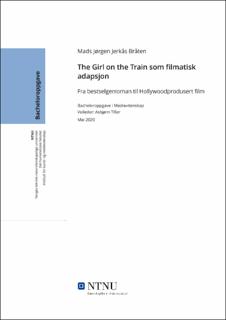| dc.contributor.advisor | Tiller, Asbjørn | |
| dc.contributor.author | Bråten, Mads Jørgen Jerkås | |
| dc.date.accessioned | 2022-02-18T18:23:08Z | |
| dc.date.available | 2022-02-18T18:23:08Z | |
| dc.date.issued | 2020 | |
| dc.identifier | no.ntnu:inspera:53721912:31539726 | |
| dc.identifier.uri | https://hdl.handle.net/11250/2980230 | |
| dc.description.abstract | Den britiske psykologiske thrillerromanen The Girl on the Train, skrevet av Paula Hawkins, gjennomgikk i 2016 en filmatisk adapsjon regissert av Tate Taylor. Den filmatiske adapsjonen skapte store forventninger og lokket både med en rekke filmstjerner i rollebesetningen og en kjent Hollywoodregissør. Oppgaven har med dette som utgangspunkt følgende problemstilling: Hvordan oversettes den britiske psykologiske thrillerromanen The Girl on the Train fra bok til en hollywoodprodusert film? De områdene som det blir lagt mest vekt på i oppgaven for å besvare denne problemstillingen er filmens miljø- og karakterskildringer. I analysen av det valgte empiriske materialet, som består av romanen og filmen, anvendes en rekke relevante begreper som det blir gjort rede for i oppgavens teoridel. Blant disse begrepene står adapsjonsbegrepet sentralt, og dette begrepet blir også diskutert i forhold til begrepet transmedial storytelling for å tydeliggjøre ulike perspektiver på adapsjon. Dessuten inneholder teoridelen en redegjørelse for diverse filmtematiske begreper, som for eksempel mise-en-scène, narrativ og kinematografi, for å legge et bredere grunnlag for analysen av materialet. Etter teoridelen blir det empiriske materialet presentert og de utvalgte fokusområdene beskrevet og begrunnet i en metodedel, som også inkluderer en beskrivelse av et utvalg scener og passasjer som det vil bli sett nærmere på i analysedelen. Analysen av The Girl on the Train som filmatisk adapsjon blir innledet med en synopsis for handlingsforløpet etterfulgt av en kort sammenligning av handlingsforløpene i boken og filmen. Deretter foretas det en grundigere analyse ved at det ses nærmere på endringer fra bok til film i lys av adapsjonsbegrepet og relevante filmtematiske begreper. Denne analysen av generelle endringer blir videre utdypet gjennom en nærmere analyse av utvalgte scener og passasjer. Til sammen dokumenterer denne analysen hvordan spesielt adapsjonsbegrepet, men også filmtematiske begreper (f.eks. mise-en-scène) kan anvendes som analyseredskaper for å forstå hvordan en filmatisk adapsjon kan formidle det samme grunnleggende narrativet i et nytt medium samtidig som det skapes et nytt verk. | |
| dc.description.abstract | The British psychological thriller novel The Girl on the Train, written by Paul Hawkins, went through a film adaptation in 2016 directed by Tate Taylor. The film adaptation created great expectations and tried to attract viewers with both multiple film stars in the cast and a well-known Hollywood director. With this as the foundation, the thesis paper asks the following question: How does the British psychological thriller novel The Girl on the Train translate into a Hollywood produced film? The areas that receive the most attention to answer the thesis question is environment- and character depiction. In the analysis of the chosen observational material, which includes the novel and the film, a lot of relevant terms will be described in the paper’s theoretical framework. Among these terms, the term adaptation remains especially important, and adaptation is also discussed in relation to transmedia storytelling to clarify the different perspectives on adaptation. The theory section will also include an explanation of several cinematical terms, such as mise-en-scène, cinematography and narrative, to widen the basis of the analysis of the chosen material. Following the theoretical section, the empirical material will be presented in the methods section that also includes a description of chosen scenes from the film that will be further discussed in the analysis. The analysis of the Girl on the Train as a film adaptation is introduced by a synopsis of the plot followed by a short comparison between the plot in the novel and film. After that, a more thorough analysis follows by looking at the changes made from the novel to the film considering the term adaptation and the relevant cinematical terms. This analysis of the general changes is further explained through specific scenes and examples. Altogether, this analysis documents how especially the term adaptation, but also cinematical terms (e.g. mise-en-scène) can be applied as tools for analysis to understand how a film adaptation can convey the same basic narrative within a new medium, but simultaneously create an artwork within itself. | |
| dc.language | | |
| dc.publisher | NTNU | |
| dc.title | The Girl on the Train som filmatisk adapsjon: Fra bestselgerroman til Hollywoodprodusert film | |
| dc.type | Bachelor thesis | |
